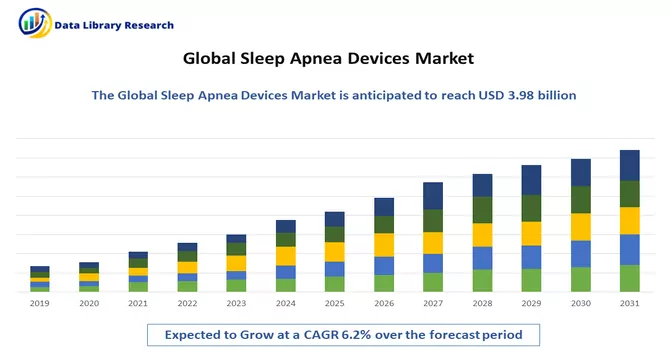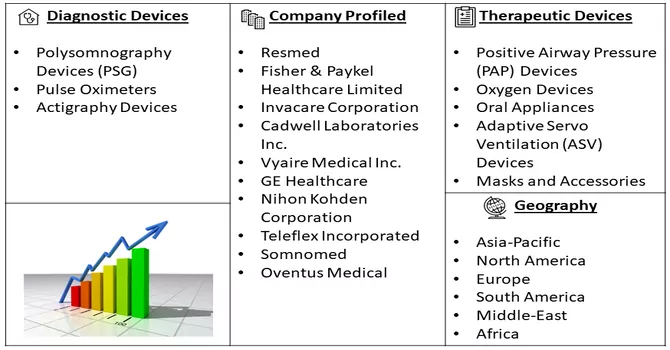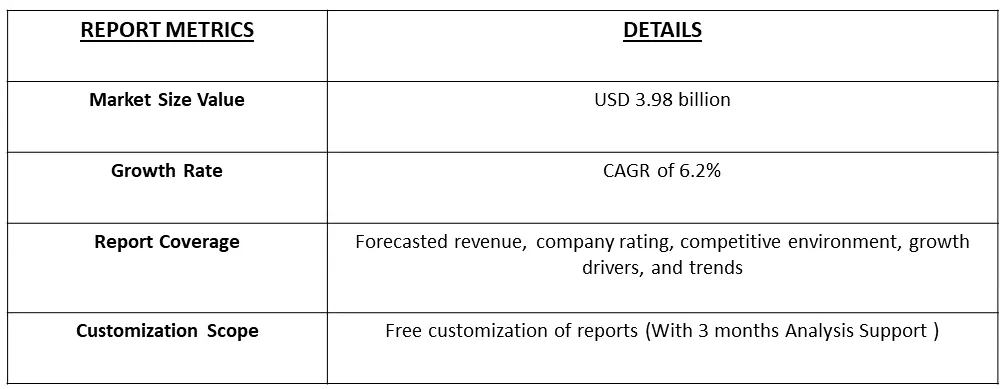The global sleep apnea devices market size was valued at USD 3.98 billion in 2022 and is expected to grow at a CAGR of 6.2% from 2023 to 2030.

Get Complete Analysis Of The Report - Download Free Sample PDF
The Sleep Apnea Devices consists of encompasses various medical devices and equipment designed to diagnose, treat, or manage sleep apnea—a condition characterized by pauses in breathing during sleep. These devices aim to ensure continuous airflow, improve breathing, and promote better sleep quality for individuals affected by sleep apnea.
The factors that are driving the growth of the studied market are the growing awareness among both healthcare professionals and the public about sleep apnea's health implications is leading to more diagnoses and subsequent demand for treatment devices. The rising incidence of sleep apnea, often associated with factors like obesity, lifestyle changes, aging populations, and sedentary lifestyles, contributes to the demand for effective treatment options.
The continual innovations are centered on enhancing the user-friendliness, noise reduction, and portability of devices. Progress in sensor technology, connectivity, and data analysis is geared towards enhancing the efficacy of treatments and user satisfaction. The incorporation of telemedicine facilitates the remote monitoring of individuals utilizing sleep apnea devices. This development empowers healthcare practitioners to monitor patient advancements, modify treatments, and offer timely interventions without the necessity for in-person appointments.
Market Segmentation: The Global Sleep Apnea Devices Market segmented by Diagnostic Devices (Polysomnography Devices (PSG), Pulse Oximeters, and Actigraphy Devices), Therapeutic Devices (Positive Airway Pressure (PAP) Devices, Oxygen Devices, Oral Appliances, Adaptive Servo Ventilation (ASV) Devices, and Masks and Accessories), and Geography (North America, Europe, Asia-Pacific, Middle East & Africa, and South America). The report offers the value (in USD million) for the above-mentioned segments.

For Detailed Market Segmentation - Download Free Sample PDF
Market Drivers:
Increasing Awareness and Diagnosis
Sleep apnea is a severe and potentially life-threatening sleep disorder that often remains undiagnosed and untreated. However, several government initiatives aim to support individuals suffering from obstructive sleep apnea (OSA). Notably, in the United States, the American Sleep Apnea Association (ASAA), a non-profit organization, plays a pivotal role in raising awareness about sleep apnea. The ASAA is dedicated to advancing ongoing improvements in treatments and actively advocates for the interests of individuals affected by sleep apnea. Through its initiatives, the ASAA not only strives to increase public understanding of sleep apnea but also works towards fostering advancements in the field of treatment. By serving as an advocate, the organization plays a crucial role in representing the needs and concerns of sleep apnea patients. This collaborative effort between non-profit organizations and government initiatives contributes to a comprehensive approach aimed at addressing the challenges posed by sleep apnea, ultimately improving diagnosis rates and ensuring individuals receive the necessary support and treatment for this serious sleep disorder.
Technological Advancements and Innovation
The continuous evolution of technology plays a pivotal role in propelling the sleep apnea market forward. Manufacturers consistently strive to enhance the design, functionality, and features of sleep apnea devices. These improvements are geared towards achieving greater user-friendliness, comfort, and efficacy in treating sleep apnea. Market growth is driven by innovations such as more compact and quieter devices, refined mask designs, remote monitoring through data connectivity, and the incorporation of artificial intelligence for personalized therapy. Technological advancements not only elevate the overall patient experience but also contribute to improved treatment adherence, thereby expanding the market for sleep apnea devices.
A notable example of industry progress occurred in January 2021 when ResMed strategically acquired Ectosense to fortify its market presence and advance the diagnosis of sleep apnea. This acquisition positions ResMed to address a substantial underserved market, as approximately 80% of the global sleep apnea population, estimated at 936 million individuals, remains undiagnosed. Thus, due to the above-mentioned factors, the market is expected to witness significant growth over the forecast period.
Market Restraints:
High Cost of Devices and Low Patient Compliance
A significant obstacle in the sleep apnea device market is the relatively high cost associated with certain devices. This financial barrier can restrict access to treatment, particularly in regions with limited healthcare resources or for individuals lacking sufficient insurance coverage. The affordability challenge poses a hindrance for many patients seeking these devices, thereby impeding market growth. Moreover, non-compliance with prescribed therapy emerges as a common issue in the treatment of sleep apnea. Some patients encounter discomfort or inconvenience in using the devices during sleep, leading to inconsistent usage or outright discontinuation of treatment. This lack of adherence negatively impacts the effectiveness of therapy and, in turn, has repercussions for the market by limiting the recurring sales of consumables linked to these devices. Thus these factors are expected to slow down the growth of the studied market over the forecast period.
In the initial phases of the pandemic, the global supply chain and manufacturing processes experienced disruptions, attributable to lockdowns, restrictions, and safety measures. These measures significantly impacted the production and distribution of sleep apnea devices, causing delays in deliveries, shortages of essential components, and hindrances in device availability in specific regions. Concurrently, lockdowns and restrictions on non-essential medical services prompted many sleep clinics to either reduce operations or temporarily close.
This scenario led to the postponement or cancellation of sleep studies and diagnostic tests for sleep apnea, thereby creating a ripple effect on the demand for sleep apnea devices. Furthermore, in accordance with an article published by the Sleep Foundation Organization in March 2022, the COVID-19 pandemic had notable effects on sleep patterns. The article highlighted that COVID-19 altered and interrupted sleep in various ways. Studies indicated a significant increase in the prevalence of insomnia symptoms among adults, children, and adolescents, with almost 40% of individuals reporting difficulties in sleeping.
This surge in sleep disorders persisted even post-pandemic, implying a lasting impact on the sleep apnea market in the foreseeable future. The confluence of disrupted supply chains, reduced access to diagnostic services, and the pervasive impact of altered sleep patterns has created a complex landscape for the sleep apnea market. As the world adjusts to the post-pandemic era, the industry is likely to navigate through these challenges, with ongoing implications for both supply and demand dynamics in the sleep apnea devices market.
Segmentation Analysis:
Polysomnography Devices is Expected to Witness Significant Growth Over the Forecast Period
Polysomnography (PSG) devices hold immense importance in the sleep apnea market, serving as the definitive standard for diagnosing a range of sleep disorders, including sleep apnea. These devices play a pivotal role in the realm of sleep clinics or laboratories, where they are employed to conduct extensive sleep studies. During these studies, PSG devices meticulously monitor various physiological parameters throughout the sleep cycle, providing a comprehensive analysis of an individual's sleep patterns and identifying any abnormalities or disruptions.
The intricate nature of PSG devices allows healthcare professionals to gain in-depth insights into a patient's sleep architecture. By recording and analyzing factors such as brain waves, eye movements, muscle activity, heart rate, respiratory efforts, and other vital signs, PSG devices enable a thorough examination of sleep quality and the presence of disorders like sleep apnea. The information obtained from these studies aids in accurate diagnosis and the development of tailored treatment plans for individuals experiencing sleep-related issues.
Thus, PSG devices stand as a cornerstone in the diagnosis and understanding of sleep disorders, contributing significantly to the effective management of conditions such as sleep apnea within the broader landscape of sleep medicine.
Positive Airway Pressure (PAP) Devices Segment is Expected to Witness Significant Growth Over the Forecast Period
Positive Airway Pressure (PAP) devices play a pivotal role in the sleep apnea devices market, functioning by delivering a continuous stream of pressurized air into the airway to prevent its collapse during sleep, effectively treating obstructive sleep apnea (OSA). The significance of this category is further underscored by the rising global prevalence of sleep apnea, projecting a favorable trajectory for the segment in the forecast period.
As indicated in a study published in the American Journal of Respiratory and Critical Care Medicine in July 2021, the global prevalence of OSA was reported at 22.6% (95% confidence interval, 20.9-24.3%). Notably, the likelihood of misdiagnosis in individuals with OSA based on a single night's assessment ranged between approximately 20% and 50%. This escalating prevalence of sleep apnea is anticipated to be a key driver of growth for the PAP device segment. Medtronic, a prominent player in the market, contributes to this segment with its Nellcor portable SpO2 patient monitoring system, PM10N. This pulse oximeter is designed for instant checks and continuous monitoring in diverse healthcare and home use settings, featuring an ergonomic shape and a user-friendly design for intuitive operation. The availability of such devices is poised to positively impact market growth.
Furthermore, ongoing developments, including product launches, approvals, partnerships, collaborations, mergers, and acquisitions, are shaping the landscape of this segment. A noteworthy example is the January 2021 launch by Telehealth company Tyto Care of its FDA-cleared fingertip Pulse Oximeter (SpO2) medical device, enabling remote monitoring of blood oxygen saturation levels and heart rate.
In summation, the combined influence of these factors is expected to significantly contribute to the growth of the PAP device segment in the sleep apnea devices market.
North America Region is Expected to Witness Significant Growth Over the Forecast Period
North America stands as a stronghold for healthcare infrastructure and a breeding ground for technological innovation. The region consistently experiences progress in the field of sleep apnea devices, encompassing CPAP machines, BiPAP devices, oral appliances, and diagnostic tools. These continual advancements are geared towards enhancing user comfort, device effectiveness, and connectivity for remote monitoring, contributing substantially to market expansion.
The prevalence of sleep apnea in North America is noteworthy, with a significant segment of the population grappling with this disorder. Lifestyle factors, including obesity, sedentary lifestyles, and an aging demographic, contribute to the heightened incidence of sleep apnea. As awareness regarding the untreated health ramifications of sleep apnea grows, there is a parallel surge in the demand for diagnostic and treatment devices.
For instance, a study published in UpToDate in January 2022 revealed an estimated prevalence of 15 to 30% in males and 10 to 15% in females in North America. The same study linked a 10% increase in weight to a six-fold rise in the risk of obstructive sleep apnea (OSA). Another study published by Clocks and Sleep in February 2022 highlighted a higher proportion of males (16.3%) in the moderate to severe OSA category compared to females. Additionally, 12.9% of individuals with moderate to severe OSA fell within the 18-39 years age group. The prevalence of obesity in this study was substantial, reaching 49.4%, with 38% of males and 58% of females classified as obese.
Thus, the given these factors, the growing prevalence of obesity is anticipated to fuel the demand for sleep apnea solutions, thereby propelling market growth in the North American region throughout the forecast period.

Get Complete Analysis Of The Report - Download Free Sample PDF
The global market for sleep apnea devices is characterized by intense competition, featuring numerous prominent players worldwide. In the face of escalating technological progress and product breakthroughs, medium-sized and smaller enterprises are expanding their market footprint by introducing novel devices at competitive price points. Some of the companies working in this market segment are:
Recent Developments:
1) In November 2022, ResMed and Verily, Alphabet's life science subsidiary, unveiled the establishment of Primasun. This comprehensive solution is geared towards aiding employers and healthcare providers in the identification of populations susceptible to intricate sleep disorders.
2) October 2022 witnessed Airway Management, renowned for producing the most extensively researched custom oral appliances globally, introducing flexTAP. This high-quality, laboratory-made oral appliance is specifically crafted to address the needs of patients dealing with snoring and mild to moderate obstructive sleep apnea.
Q1. What was the Sleep Apnea Devices Market size in 2022?
As per Data Library Research the global sleep apnea devices market size was valued at USD 3.98 billion in 2022.
Q2. At what CAGR is the Sleep Apnea Devices Market projected to grow within the forecast period?
Sleep Apnea Devices Market is expected to grow at a CAGR of 6.2% over the forecast period.
Q3. What are the factors on which the Sleep Apnea Devices Market research is based on?
By Diagnostic Devices, Therapeutic Devices, End-User and Geography are the factors on which the Sleep Apnea Devices Market research is based.
Q4. What are the factors driving the Sleep Apnea Devices Market?
Key factors that are driving the growth include the Increasing Awareness and Diagnosis and Technological Advancements and Innovation.
Data Library Research are conducted by industry experts who offer insight on industry structure, market segmentations technology assessment and competitive landscape (CL), and penetration, as well as on emerging trends. Their analysis is based on primary interviews (~ 80%) and secondary research (~ 20%) as well as years of professional expertise in their respective industries. Adding to this, by analysing historical trends and current market positions, our analysts predict where the market will be headed for the next five years. Furthermore, the varying trends of segment & categories geographically presented are also studied and the estimated based on the primary & secondary research.
In this particular report from the supply side Data Library Research has conducted primary surveys (interviews) with the key level executives (VP, CEO’s, Marketing Director, Business Development Manager and SOFT) of the companies that active & prominent as well as the midsized organization
FIGURE 1: DLR RESEARH PROCESS

Extensive primary research was conducted to gain a deeper insight of the market and industry performance. The analysis is based on both primary and secondary research as well as years of professional expertise in the respective industries.
In addition to analysing current and historical trends, our analysts predict where the market is headed over the next five years.
It varies by segment for these categories geographically presented in the list of market tables. Speaking about this particular report we have conducted primary surveys (interviews) with the key level executives (VP, CEO’s, Marketing Director, Business Development Manager and many more) of the major players active in the market.
Secondary ResearchSecondary research was mainly used to collect and identify information useful for the extensive, technical, market-oriented, and Friend’s study of the Global Extra Neutral Alcohol. It was also used to obtain key information about major players, market classification and segmentation according to the industry trends, geographical markets, and developments related to the market and technology perspectives. For this study, analysts have gathered information from various credible sources, such as annual reports, sec filings, journals, white papers, SOFT presentations, and company web sites.
Market Size EstimationBoth, top-down and bottom-up approaches were used to estimate and validate the size of the Global market and to estimate the size of various other dependent submarkets in the overall Extra Neutral Alcohol. The key players in the market were identified through secondary research and their market contributions in the respective geographies were determined through primary and secondary research.
Forecast Model
